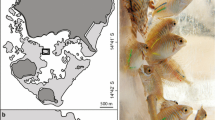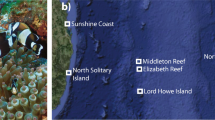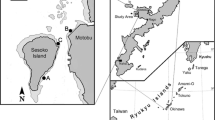Abstract
Nine anemonefish species were reared in the laboratory, and individuals were released in the field (Lizard Island, Australia and Madang, Papua New Guinea) at different distances and orientations away from natural (anemone species the fishes are found with in nature) and unnatural species of host anemones. Experiments were conducted to examine factors that could affect the settlement behaviors of the fishes: current velocity, distance and orientation of the fishes to the anemones, chemical vs visual cues, and presence of conspecific or heterospecific fishes. The fishes were usually attracted toward natural host species of anemones but not towards unnatural host anemone species nor to pieces of dead coral. Host selection during settlement provided the best explanation for the host specificity patterns displayed by anemonefishes in nature. The fishes used chemical cues released from the anemones to identify and locate the appropriate host species and could effectively locate the anemones from a maximum distance of 8 m downstream. Fishes released upstream or to the side of anemones (where anemone chemicals were assumed to be reduced or absent) were much less successful in locating anemones. The ability of the fishes to locate natural host anemones was strongly reduced when there was no water current. The presence of resident anemonefishes on host species of anemones did not influence the attraction behavior of anemonefishes released downstream from the anemones. Once the released fishes got close to or entered the anemones, the resident fishes would generally bite and chase them until the recruits left the anemones. Most fishes were not stung upon initial contact with the anemones.
Similar content being viewed by others
References
Allen GR (1972) The anemonefishes: their classification and biology. T.F.H. Publ., Inc., Neptune City
Allen GR (1973) Amphiprion leucokranos a new species of pomacentrid fish, with notes on other anemonefishes of New Guinea. Pacif Sci 27:319–326
Allen GR (1980) The anemonefishes of the world: species, care, and breeding. Aquarium Systems, Mentor, Ohio
Atema J (1985) Chemoreception in the sea: adaptations of chemoreceptors and behaviour to aquatic stimulus conditions. Symp Soc exp Biol 39:387–423
Atema J (1988) Distribution of chemical stimuli. In: Atema J, Fay RR, Popper AN, Tavolga WN (eds) Sensory biology of aquatic animals. Springer-Verlag, Berlin, pp 29–56
Bell WJ (1991) Searching behaviour: the behavioural ecology of finding resources. Chapman and Hall, London
Bossert WH, Wilson EO (1963) The analysis of olfactory communication among animals. J theor Biol 5:443–469
Butman CA (1987) Larval settlement of soft-sediment invertebrates; the spatial scales of pattern explained by active habitat selection and the emerging rôle of hydrodynamic processes. Oceanogr mar biol A Rev 25:113–165
Davenport D, Norris KS (1958) Observations on the symbiosis of the sea anemone Stoichactis and the pomacentrid fish, Amphiprion percula. Biol Bull mar biol Lab, Woods Hole 115:397–410
David CT, Kennedy JS, Ludlow AR, Perry JN, Wall C (1982) A reappraisal of insect flight towards a distant point source of windborne odor. J chem Ecol 8:1207–1215
Davis AR (1987) Variation in recruitment of the subtidal colonial ascidian Podoclavella cylindrica (Quoy and Gaimard): the role of substratum choice and early survival. J exp mar Biol Ecol 106: 57–71
Denny MW (1988) Biology and the mechanics of the wave-swept environment. Princeton University Press, Princeton
Eckert GJ (1985) Settlement of coral reef fishes to different natural substrata and at different depths. Proc (5th) Int coral Reef Congr 5:385–390 [Gabrié C et al. (eds) Antenne Museum — EPHE, Moorea, French Polynesia]
Elliott JK (1992) Factors influencing the distribution, abundance, and host specificity patterns of anemonefishes. Doctoral Dissertation. Florida State University, Tallahassee, Florida
Elliott JK, Mariscal RN, Roux KH (1994) Do anemonefishes use molecular mimicry to avoid being stung by host sea anemones? J exp mar Biol Ecol 179:99–113
Fautin DG (1985) Competition by anemonefishes for host actinians. Proc 5th int coral Reef Congr 5:373–377 [Gabrié C et al. (eds) Antenne Museum — EPHE, Moorea, French Polynesia]
Fautin DG (1986) Why do anemonefishes inhabit only some host actinians? Envir Biol Fishes 15:171–180
Fautin DG (1988) Sea anemones (Actiniaria and Corallimorpharia) of Madang Province. Sci New Guinea 14:22–29
Fautin DG (1991) The anemonefish symbiosis: what is known and what is not. Symbiosis 10:23–46
Fautin DG (1992) Anemonefish recruitment: the roles of order and chance. Symbiosis 14:143–160
Fautin DG, Allen GR (1992) Field guide to anemonefishes and their host sea anemones. Western Australian Museum, Perth
Fricke HW (1974) Öko-Ethologie des monogamen Anemonen-fisches Amphiprion bicinctus. Z Tierpsychol 36:429–513
Keough MJ (1988) Benthic populations: is recruitment limiting or just fashionable? Proc 6th coral Reef Symp 1:141–148 [Choat JH et al. (eds) Sixth International Coral Reef Symposium Executive Committee, Townsville]
Leis JM (1991) The pelagic stage of reef fishes: the larval biology of coral reef fishes. In: Sale PF (ed) The ecology of fishes on coral reefs. Academic Press, Inc., San Diego, pp 183–230
Mariscal RN (1966) The symbiosis between tropical sea anemones and fishes: a review. In: Bowman RI (ed) The Galápagos. University of California Press, Berkeley, pp 157–171
Miyagawa K (1989) Experimental analysis of the symbiosis between anemonefish and sea anemones. Ethology 80:19–46
Miyagawa K, Hidaka T (1980) Amphiprion clarkii juvenile: innate protection against and chemical attraction by symbiotic sea anemones. Proc Japan Acad 56:356–361
Moore PA, Weissburg MJ, Parrish JM, Zimmer-Faust RK, Gerhardt GA (1994) Spatial distribution of odors in simulated benthic boundary layer flows. J chem Ecol 20:255–279
Morse ANC (1991) How do planktonic larvae know where to settle? Am Scient 79:154–167
Murata M, Miyagawa-Kohshima K, Nakanishi K, Naka Y (1986) Characterization of compounds that induce symbiosis between sea anemone and anemone fish. Science, NY 234:585–587
Olson RR (1985) The consequences of short-distance larval dispersal in a sessile marine invertebrate. Ecology 66:30–39
Rodríguez SR, Ojeda FP, Inestrosa NC (1993) Settlement of benthic marine invertebrates. Mar Ecol Prog Ser 97:193–207
Sale PF (1990) Recruitment of marine species: is the bandwagon rolling in the right direction? Trends Ecol Evol 5:25–27
Sale PF (1991) The ecology of fishes on coral reefs. Academic Press, Inc., San Diego
Sale PF, Douglas WA, Doherty PJ (1984) Choice of microhabitats by coral reef fishes at settlement. Coral Reefs 3:91–100
Sokal RR, Rohlf FJ (1981) Biometry — the principles and practice of statistics in biological research, 2nd edn. Freeman and Co., San Francisco
Sweatment HPA (1983) Influence of conspecifics on choice of settlement sites by larvae of two pomacentrid fishes (Dascyllus aruanus and D. reticulatus) on coral reefs. Mar Biol 75:225–229
Sweatman HPA (1985) The influence of adults of some coral reef fishes on larval recruitment. Ecol Monogr 55:469–485
Sweatman HPA (1988) Field evidence that settling coral reef fish larvae detect resident fishes using dissolved chemical cues. J exp mar Biol Ecol 124:163–174
Thresher RE, Colin PL, Bell LJ (1989) Planktonic duration, distribution and population structure of western and central Pacific damselfishes (Pomacentridae). Copeia 1989:420–434
Underwood AJ, Fairweather PJ (1989) Supply-side ecology and benthic marine assemblages. Trends Ecol Evol 4:16–20
Verwey J (1930) Coral reef studies. I. The symbiosis between damselfishes and sea anemones in Batavia Bay, Treubia 12:305–366
Weissburg MJ, Zimmer-Faust RK (1993) Life and death in moving fluids: hydrodynamic effects on chemosensory-mediated predation. Ecology 74:1428–1443
Wellington GM, Victor BC (1989) Planktonic larval duration of one hundred species of Pacific and Atlantic damselfishes (Pomacentridae). Mar Biol 101:557–567
Williams DMcB (1980) Dynamics of the pomacentrid community on small patch reefs in One Tree Lagoon (Great Barrier Reef). Bull mar Sci 30:159–170
Williams DMcB, Sale PF (1981) Spatial and temporal patterns of recruitment of juvenile coral reef fishes to coral habitats within “One Tree Lagoon”, Great Barrier Reef. Mar Biol 65:245–253
Zar JH (1984) Biostatistical analysis, 2nd edn Prentice Hall, Englewood Cliffs, New Jersey
Author information
Authors and Affiliations
Additional information
Communicated by R. J. Thompson, St. John's
Rights and permissions
About this article
Cite this article
Elliott, J.K., Elliott, J.M. & Mariscal, R.N. Host selection, location, and association behaviors of anemonefishes in field settlement experiments. Marine Biology 122, 377–389 (1995). https://doi.org/10.1007/BF00350870
Received:
Accepted:
Issue Date:
DOI: https://doi.org/10.1007/BF00350870




